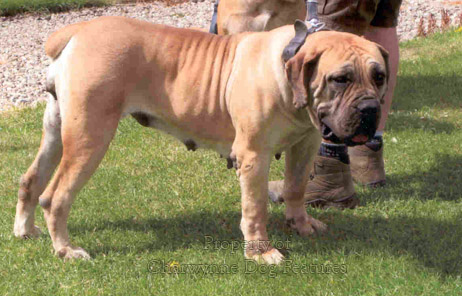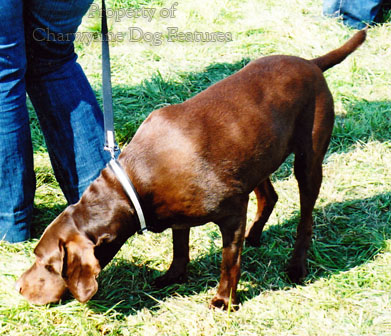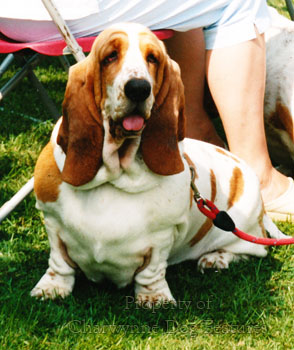564 What Are Show Dogs Fit FOR
WHAT ARE SHOW DOGS FIT FOR
by David Hancock
 Why are show ring judges awarding prizes to dogs in poor muscular condition and quite clearly not fit? Is it ignorance, incompetence or indifference? Some of the judges I watch simply do not know soft muscle from hard and seem incapable of detecting the absence of muscular development. I shudder to think where this will lead us! Judging livestock is essentially a subjective skill based on what you see in the entry NOT what the exhibitor wants you to see. Rather than a reaction to the animal before you, it is more a conscious action to relate the animal presented to you in the ring to the beau-ideal for that particular breed.
Why are show ring judges awarding prizes to dogs in poor muscular condition and quite clearly not fit? Is it ignorance, incompetence or indifference? Some of the judges I watch simply do not know soft muscle from hard and seem incapable of detecting the absence of muscular development. I shudder to think where this will lead us! Judging livestock is essentially a subjective skill based on what you see in the entry NOT what the exhibitor wants you to see. Rather than a reaction to the animal before you, it is more a conscious action to relate the animal presented to you in the ring to the beau-ideal for that particular breed.
If we are going to accept unfit exhibits lacking muscular development as challenge certificate material, then novice exhibitors are being given a wholly undesirable impression and standards have already become unacceptably low. We are in effect betraying the work of the skilful pioneer breeders who handed these fine breeds down to us. That apart, where is the pride of the breeders, owners and handlers concerned? Who admires a puny, unfit, under-developed dog or an obese flabby one? These breeds were designed to work! What sort of encouragement is this to those admirable exhibitors who spent hours getting their dogs into real show condition? Where will it all end --with prizes for fat dog of the day? 
In his informative "The Practical Guide to Showing Dogs" of 1956, Captain Portman-Graham wrote: "The fact that a dog is structurally sound is not in itself sufficient to ensure that it will always win at shows. It is of paramount importance that it must be...at the highest standard of condition..Perhaps one of the biggest advantages which dog showing confers on the dog as an animal is the care which must be bestowed upon it." If unfit dogs with poor muscular condition can win at dog shows, then the whole argument that such shows improve dogs is totally destroyed. Dogs which are inadequately exercised and merely wheeled out for the next show should be identified early by any competent judge and quickly thrown out of the ring. Are our current crop of judges up to this?
The esteemed Portman-Graham went on to write: "...exercise is a vital consideration in maintaining any breed of show dog in bloom, health and vigour...When one watches the beautiful muscles of a racehorse one sees a similarity between a dog's muscles which have been developed correctly and naturally, and ripple in movement. Yet there is evidence of lack of muscular tone and development in many show breeds today." He would not have liked the entry in show rings today. Surely such shows should be didactic not merely epideictic; in other words it has a role in teaching those wanting to learn not just being conducted literally for show. A dog show, properly conducted, should attract exhibitors not exhibitionists.

Nowadays we are bombarded with verbal and written instructions from a host of nutritionists and crafty manufacturers at shows yet I see more fat dogs these days than ever before. We all know that an overweight dog is an unhealthy dog. If exhibitors produce unhealthy dogs in the ring then every judge has a duty to point this out and decline entry to such exhibits. If a judge does not take this course of action, then a complaint should be made to the KC. This wholly undesirable situation in which unfit unhealthy dogs are allowed in show rings simply cannot be condoned. Those who exhibit dogs in a show ring have a distinct role in demonstrating to the public what the pedigree breeds should look like when presented, in show condition, to the judge. Their dogs should be exemplars of cosmetic excellence. The public as spectators, and novices as students, should not only admire what they see in the ring but be guided by the standards there. If an exhibit needs a good bath, it should, in rugby league parlance, be sent for an 'early bath'. If its claws need cutting, its teeth need cleaning, its coat needs unmatting and its eyes and ears need a thorough wipe, then the exhibit is not ready for its class and should be banished until it is. Soft- muscled and overweight dogs however pose a much more important, more long term problem.
If you purchase an expensive pedigree dog, why try to feed it to death? If you spend time and money breeding and exhibiting pedigree dogs, why frustrate yourself by putting dogs in the ring which cannot win? I should hastily add "should not win", for the judge makes this differentiation. Sixty or so years ago, Theo Marples, writing in his "Prize Dogs", put the condition of a dog in the ring ahead of its ability to 'show'. He also wrote that "It is always best not to show a dog in bad condition, even although he may be entered for a show. Manya good dog has met defeat and tarnished his reputation by being exhibited in indifferent condition". I see dogs "in indifferent condition" being presented to the judge at most of the shows I go to. What folly! Some of the owners of such dogs moan later about the standard of the judging when their dogs fail to gain a place. Winning is all about the pursuit of excellence, not just turning up on the day.
Are soft-muscled overweight exhibits now actually becoming the norm at shows? If so, then we have not only too many incompetent judges but a potential disaster on our hands. For, if, as is claimed, the improvement of dogs is the Kennel Club's mandate and dog shows are the vehicle for this, then permitting soft-muscled overweight dogs even to enter the ring substantially undermines this claim. Pedigree dog shows, and Working Breed shows in particular, must demonstrate to the dog- owning public what each breed should look like in condition. If this is not happening, then the whole credibility of pedigree dog breeding is put at risk. There is now an urgent need for us to exercise our minds as well as our dogs. Overfed, unexercised, seriously over-weight exhibits must be thrown out of every ring and class they appear in, if only to keep the animal rights movement away. But aren't these dogs in our care?